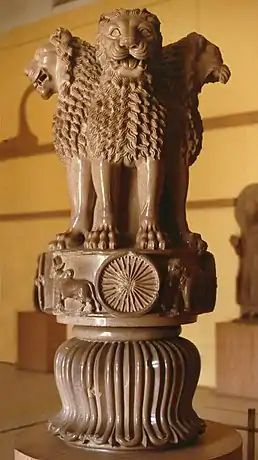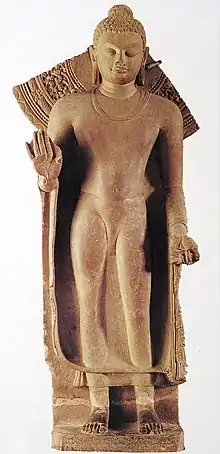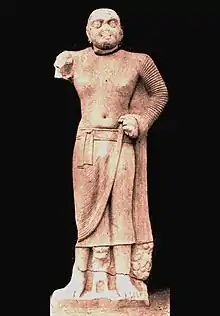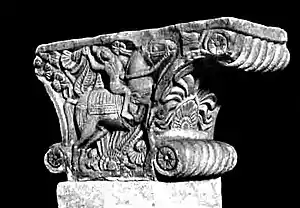Sarnath Museum
Sarnath Museum is the oldest site museum of Archaeological Survey of India. It houses the findings and excavations at the archaeological site of Sarnath, by the Archaeological Survey of India. Sarnath is located near Varanasi, in the state of Uttar Pradesh. The museum has 6,832 sculptures and artefacts.[1]
.jpg.webp) Sarnath Museum | |
 Location within India | |
| Established | 1910 |
|---|---|
| Location | Saranath (near Varanasi) |
| Type | Archaeological museum |
| Collection size | Buddhist art, sculpture, antiquities |
History
To keep the antiquities found from the site, a decision was taken in 1904 by the Government to construct a site museum adjacent to the excavated site at Sarnath. It was due to initiative of Sir John Marshall, the then Director General of Archaeology in India, that this museum was created. The plans were prepared by Mr. James Ramson, the then consulting Architect to the Government of India. The building was completed in 1910 to house, display and study the antiquities in their right perspective. The building forms half of a monastery (Sangharam) in plan.
Galleries
The museum contains five galleries and two verandahs to display the antiquities ranging from the 3rd century BCE to 12th century AD that have been found at Sarnath.
Sarnath has yielded a rich collection of sculptures, artefacts and edifices comprising numerous Buddha and Bodhisattva images and other ancient remains. Finest specimens of Buddhist art and other important remains have been housed at the museum.
While the single most famous exhibit of this museum is the Lion Capital of Ashoka, the Sarnath museum also houses a collection of other Buddhist artefacts. Among the things to see is a sculpture of the Buddha from the 5th century. The Buddha sits cross-legged, with eyes downcast in deep meditation, and a halo around his head. Also worth exploring are the several figures of the bodhisattvas.
Of other Buddhist remains, there is a life-size standing Bodhisattva and a delicate image of the Bodhisattva with a lotus and yet another bronze sculpture showing the Bodhisattva with multiple arms. The museum at Sarnath also houses a collection of figures and sculptures from the Mauryan, the Kushana and the Gupta periods. Prominent among them is the earliest Buddha image found at Sarnath and many images of Hindu Gods dating from the 9th to 12th centuries.
Ashoka's Lion capital
This is the famous original sandstone sculpted Lion Capital of Ashoka preserved at Sarnath Museum, which was originally erected around 250 BCE atop an Ashoka Pillar at Sarnath. The angle from which this picture has been taken, minus the inverted bell-shaped lotus flower, has been adopted as the National Emblem of India showing the Horse on the left and the Bull on the right of the Ashoka Chakra in the circular base on which the four Indian lions are standing back to back. On the far side there is an Elephant and a Lion instead. The wheel "Ashoka Chakra" from its base has been placed onto the centre of the National Flag of India. The fragments of the stone dharma-chakra that was once atop the lions, are now displayed nearby.[2]
Main collections
 Lion Capital of Ashoka in the museum.
Lion Capital of Ashoka in the museum. Buddha, standing, inscribed Gift of Abhayamira in 154 GE 474 CE in the reign of Kumaragupta II, Sarnath Museum.
Buddha, standing, inscribed Gift of Abhayamira in 154 GE 474 CE in the reign of Kumaragupta II, Sarnath Museum.
.jpg.webp) Gupta period Dharmachakra Pravartana Buddha.
Gupta period Dharmachakra Pravartana Buddha. 5th century Buddha.
5th century Buddha.
References
- Singh, Binay (26 March 2011). "A rich repertoire of glorious past". Varanasi: Times of India. TNN. Retrieved 4 December 2012.
- John Huntington. Understanding the 5th Century Buddhas of Sarnath: A Newly Identified Mudra and a New Comprehension of the Dharmachakra Mudra, Orientations, March 2009, p 84-93
